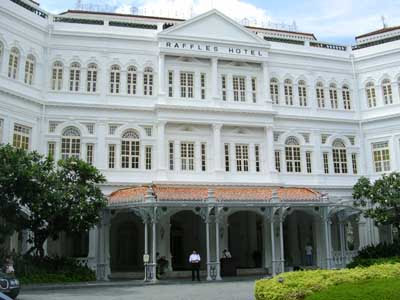







Friday 9th November 2007 - Singapore
We arrived at Singapore early in the morning and waited for most folk to be processed through customs before alighting at the ultra-modern Cruise Terminal at about 10.00am. We had walk off facilities and no steps (like airports used to be) and were deposited in a building with turn-key facilities including tourist information, ATMs/money changers, shopping centre, bus station, underground station and aerial cableway. Nowhere in the UK could compete; and not just at the harbour side.
We took advice and first went by metro to Chinatown. The Singapore MRT is state-of-the-art and probably the best and most efficient underground in the world. All announcements are in English, trains run on time and station platforms are like Stanstead airport where doors on the tube align with doors on the platform; and, of course, waiting times are displayed on illuminated boards. Furthermore, there's no litter, either on tubes, stations or the streets. Standard tickets are electronic cards with a 1 dollar deposit, returned on completion of the journey, and all tickets are 'flash at the terminal'. Eat your heart out London Underground.
Unfortunately, shops don't open in Singapore until 11.00am because they run their clocks on what amounts to a permanent summer time. Also, the Chinatown area is clearly at its best when the night market is on. Nevertheless, we saw many original buildings including a re-furbished Buddhist centre and assorted market stalls. Streets tend to be dedicated here and we went along Sago Street, also known as Death Street. Apparently, the indigenous Chinese (indigenous from about the 1830s onwards) consider it bad luck to die at home as this passes on bad luck to the remaining household. Therefore, they go to specialist houses to die; a practice only abandoned 40 years ago. Unsurprisingly the Death Houses turned into Funeral Parlours!! Next was a food street where all properties fronted hawker food stalls; again too early to eat. We found ourselves eventually on South Bridge Street and decided to walk the 6 or 7 blocks to the Singapore river.
On the way, we passed many neat and standardised tourist information boards which at Hokien street advised us that the building of Singapore was largely done by Chinese women who were never able to afford to return to their families in China. Effectively, indentured labour, they had specific head gear to distinguish building labourers from dock labourers and the whole operation was done manually. We saw some of their old buildings in China square and a number of areas have been preserved, but there is a real dash for modernisation in this city. We then reached Elgin Bridge and without quite planning it found ourselves at Raffles Landing Site and statue (the English guy who founded Sinpapore in 1819 or so). We took a cruise for an hour on the river, both to Marina Bay and upstream too. There are a number of preserved isolated areas where original buildings have been preserved, particularly in the Colonial district and largely featuring public buildings, but the rest of the stretch is ultra modern with a skyline the likes of which we have never seen before. There are higher skyscrapers in New York, but not such a concentration as there are in Singapore.
After the cruise, we walked though the Colonial district, taking in City Hall etc and the Singapore Cricket Club and past St Andrews Cathedral, looking rather incongruous in this largely Buddhist republic. We then headed for Raffles Hotel, the rather iconic destination where one is supposed to purchase a gin sling in the long bar. Unfortunately, this has been re-sited to a peripheral local (to keep tourists away from guests) and at 28 dollars a throw including tax and service (£9.30 where you are) the gin sling is not a value-for-money purchase. The hotel though is a splendid building but very much cashes in on snob value. Instead we headed for the Swiss hotel to post our blog. This, too, was expensive - £3.30 for 15 minutes - and illustrates that at the top end of the market Singapore is not cheap. OK for laptops though!
We headed through an unbelievable underground shopping centre come link walkway - there are endless, super-modern, air-conditioned shopping malls in the centre - and sought out the underground to Little India for a bit more 'ethnic' Singapore. This day was Diwali and all the celebrations were in full swing but we took the best part of an hour out over a couple of beers at Tekka market on the edge of the area. There appears to be excellent racial tolerance in Singapore, but areas are still tightly demarcated with one side of the market distinctly Chinese and the other Indian. We walked the streets of Little India for about an hour, noting the usual stalls, Hindu temples etc and garland shops, doing a brisk trade for the holiday. Again, although not as clean as downtown, there was little or no litter about even in the market. Apparently, it is a serious offence to litter and also to fail to flush toilets. Locals make a packet selling tee-shirts with at least nine or ten pseudo street signs saying what you cannot do in Singapore. The high quality environment comes at quite a price on civil liberties, but, as we say in the north, 'you don't get ought for nought'. We were left overall with a most impressive impression of the place and would have liked more time here.
We dashed on the tube back to the Cruise terminal to find ourselves confounded with 2,500 passengers departing on another Cruise ship. Total chaos - it even happens in Singapore - and we finally put to sea 40 minutes late.